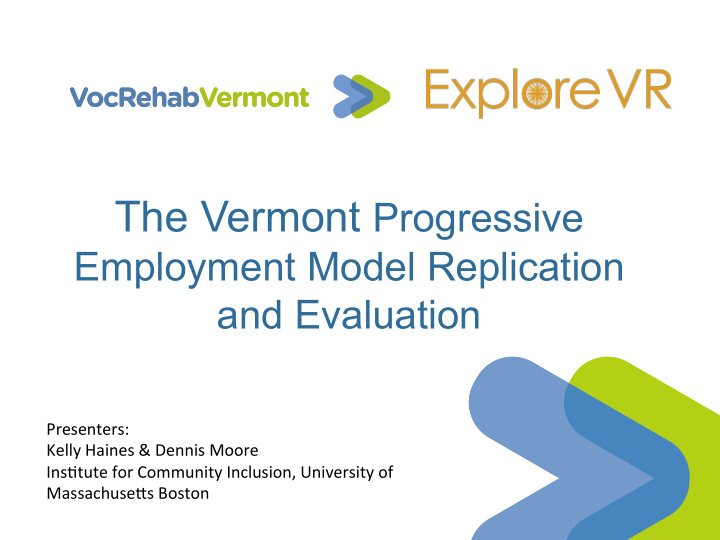



The Vermont Progressive Employment Model Replication and Evaluation Presenters: ¡ Kelly ¡Haines ¡& ¡Dennis ¡Moore ¡ Ins4tute ¡for ¡Community ¡Inclusion, ¡University ¡of ¡ Massachuse>s ¡Boston ¡
VR-RRTC on Demand Side Strategies The Vocational Rehabilitation Research and Training Center (VR-RRTC) on Demand-Side Strategies is a national center for improving vocational rehabilitation (VR) responsiveness to employer needs. • Funded by the National Institute on Disability, Independent Living, and Rehabilitation Research (NIDILRR) Grant # H133B120002. • Project Partners: VR agencies in VT, NE, AL and CSAVR
Talking points for the session • VTPE: What exactly are we studying? • How are we doing it? • What have we learned so far? • What is next?
Video clip
VTPE: Key features • Dual customer design • Team approach • Focus on high-risk or difficult to place consumers • Emphasis on rapid engagement • Mechanism for set-asides or training offsets or work experience pay • Liability and workers’ compensation insurance for trainees • Data tracking tools for jobseekers and employers
Study Design: Key features • Learning collaborative approach for model replication • Impact evaluation • Process evaluation
But first - • Define and “extract” the model • How do you take something that developed organically in Vermont, package it up, and test it out in another state? • Convince others to try it out (as part of a research study)
Build a Learning Collaborative • LC as a research vehicle – Peer-to-Peer support – Wrap around training/TA – Tweaked from previous LCs: Embedded evaluation • RFP process: accessible • Research requirements: negotiable • 4 states joined
Impact Evaluation: Design • Develop customized evaluation plans • Data points: VTPE yes/no, work experience type and “dose”, milestone dates – Link to CMS [outcome data]? – Link to employer data?
Process evaluation: Design • Fidelity visits/observations • Ongoing site visits, phone calls, informal check-ins, LC meetings • Semi-structured interviews near end of implementation cycle • Qualitative effort to capture jobseeker and employer perspective (in design)
Overall: Flexible & dynamic study design Ongoing impact evaluation data analysis and process evaluation (fidelity reviews) inform: 1. Research methodology & model refinement 2. Training & TA 3. Plans for future research
What have we learned so far?
Nebraska • Parallel pre-existing philosophy to VT VR • Rapid Engagement promoted, within context of voc eval • All clientele potentially eligible statewide • 4 Business Account Managers (BAM) • All employ services in house
Oregon (Commission for the Blind) • Small agency (~13 VRC), rural aspect • Primary target group, clients 2+ yrs in • 1 BAM statewide • CRPs assist with placement
Maine • Transition youth Portland, Lewiston • 1 BAM • Selected CRPs deliver PE employ services
Florida (Division of Blind Services) • Larger agency • 7 districts starting with stuck cases (2 yrs +) • 1 BAM serves 7 districts • In house employment specialists, eventually CRPs to assist
Early observations • VR programs vary widely in policy/ procedures that could impact model (both across agencies and within agencies) • CRP vs inhouse employment services
Early observations, cont. • Team approach from earliest contact • VRC and employment staff - handoff vs active participation • Roles of employment specialists, VRCs, BAMs, CRPs supportive of VTPE
Early observations, cont. • Early engagement is encouraged • Can services be delivered prior to plan? • Plan can be easily modified? • What is “job readiness”?
Early observations, cont. • Agency position/policy regarding dual customer approaches that include employers • Work experience compensation (set aside) and liability insurance
Future • Moving along the continuum of innovative practices – from Emerging � Promising � Evidence-Based (citation: RRTC on EBP) • NIDILRR Stages of Research
For more information • Visit: ExploreVR.org for more resources on Progressive Employment • Contact us: – Kelly.Haines@umb.edu – Dennis.Moore@wright.edu
Recommend
More recommend